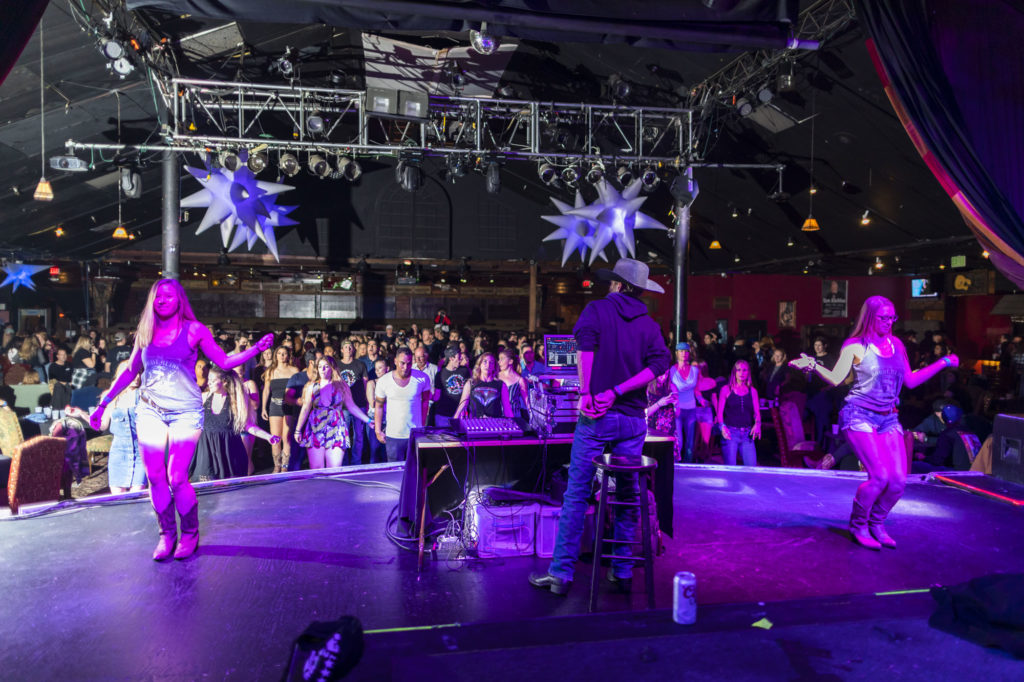
Borderline country night at The Canyon Club in Agoura Hills. Photo by Brian Feinzimer.
By the time the gunman fired his second round of shots at Borderline Bar & Grill in Thousand Oaks, 25-year-old Dani Merrill was already in flight mode, sprinting with her roommate toward the kitchen. She knew how to find it because one of her best friends, Megan Hickernell, used to bartend there. It helped that Merrill had been going to the 18-and-over spot, sometimes multiple times a week, for the entirety of her adult life.
The kitchen of Borderline Bar & Grill leads to the loading dock, where just before midnight on November 7, 2018, Merrill collided with another person fleeing the bar. She injured her knee, but kept running. She knows it could have been worse. She and her roommate never parked on that side of the bar, but for whatever reason, they had that night. It’s a detail that still sticks out as odd in Merrill’s mind. After picking up another survivor who was stranded outside Borderline without a car, Merrill and her roommate gassed it toward a maze of red-tile roofed parking lots on the other side of the Ventura Freeway and waited with the woman at a gas station until her ride came. Sirens cut through the quiet of the suburban night. Merrill never got the woman’s name. Until she got home that night, she never dropped her guard.
“If anything starts moving, we need to move,” she remembers thinking. “You don’t know if there’s one [shooter], you don’t know what they’re doing, because there’s multiple bars in that area.”
Merrill had begun to think like a military strategist. Or more aptly, like someone who had been through a mass shooting before. Thirteen months earlier, she’d fled from round after round of rapid gunfire during Route 91 Harvest music festival in Las Vegas, Nevada. The massacre claimed 58 lives and injured hundreds more, making it modern America’s deadliest mass shooting.
Merrill is not the only country music fan to have survived both mass murders, each carried out by lone white men who then turned the gun on themselves, and whose motives are still unclear. One gunman was a 64-year-old gambler and real estate investor who lived just outside Las Vegas; the other, a 28-year-old U.S. Marine Corps veteran who reportedly posted messages on Facebook and Instagram mid-massacre. (The FBI closed its investigation of the Las Vegas shooting in January; its investigation into the Thousand Oaks shooting is ongoing.)
While Borderline Bar & Grill remains closed indefinitely, its regulars, some of whom have survived two mass shootings in less than two years, are working to rebuild their community. Other venues, like The Canyon Club, have picked up the slack, hosting Borderline Country Nights—led by Borderline’s former DJs and dance instructors—at both its Agoura Hills and Santa Clarita locations. But as Borderline’s regulars attempt to find normalcy again, few in these conservative-leaning pockets of Los Angeles and Ventura Counties are calling for tighter gun control. Unlike survivors of the mass shooting in Parkland, Florida, who used their grief and anger to kickstart a national movement for gun control last year, many of those who were affected by the Thousand Oaks shooting prefer not to engage in politics at all.
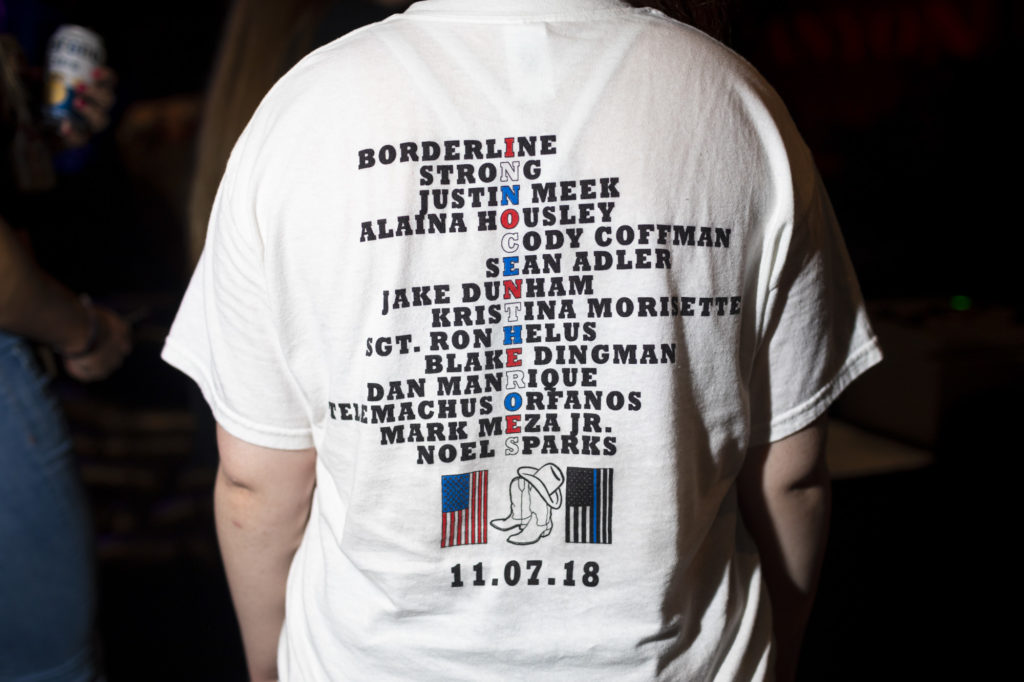
On the first Saturday in December, Harley’s Valley Bowl, the anchor of a Simi Valley shopping center that looks unchanged since the 1980s, is packed with the same crowd that once packed nearby Borderline Bar & Grill. It’s a deceivingly sunny 60-degree-day that calls for a coat, but most people here wear T-shirts: T-shirts bearing the names of barely-21-year-old friends who died in the shooting; T-shirts covered with heart-shaped American flag patterns; T-shirts printed with the words “Borderline Strong,” a riff on the #Route91Strong and #CountryStrong hashtags that emerged the previous fall. Some people wear flannel or camouflage. Nearly everyone wears cowboy boots.
Neon lights bounce around the lanes of the bowling alley like lasers while Faith Hill and Tim McGraw sing a ballad on flat screens. A football game plays on the TV inside the bar, where a dozen foam-core-mounted posters adorn a long wooden table in the middle of the room. Mounted on each poster is a photo of one of the shooting victims. Friends and family have scrawled notes in Sharpie on the margins. “Hope you’re enjoying a Shirley Temple,” former Borderline bartender Hickernell wrote on the poster for Noel Sparks, a 21-year-old Moorpark College student who died in the shooting. Hickernell drew the outline of a cherry. “You will be missed on the dance floor.”
The note is a tribute to Sparks’ drink of choice. “She just always got a Shirley Temple and I always made sure there was a cherry because who doesn’t want a Shirley Temple with a cherry?” says Hickernell, 25, who wears her long blonde hair draped down her back. “Sometimes us dancers don’t always drink because it messes up our footwork.”
“Noel, may you dance with the ‘redneck angels’ above,” wrote Cody Seybold, a 25-year-old Borderline DJ and concert promoter who lives in Santa Clarita. It’s a reference to a line dance that Sparks used to request. “That’s the biggest memory of her I have because she’d always come up and ask for that dance,” Seybold says, wearing a gray baseball t-shirt with the logo of Borderline Bar & Grill. “Some of the dances we do are the name of a song. That one, I don’t know how it got that name.” Above Sparks’ photo is a note scrawled in swirly green letters. It reads, simply: “I love you Noel. Dad.”
Michael Steinhauser, a Borderline regular and Route 91 survivor, organized today’s event to raise money for the families of the 12 people killed in the shooting. There’s a raffle offering a bowling pin signed by rock star turned reality star Eddie Money, a pair of tickets to see country musician Dwight Yoakam at the Ventura Theater, various signed sports memorabilia from the L.A. Kings and L.A. Dodgers, and Borderline Bar & Grill-branded t-shirts and stickers for sale. This isn’t the first time Harley’s has hosted a fundraiser in the wake of a mass shooting: Last year, Steinhauser held a similar event here that raised more than $4,000 for the families of victims of the Route 91 shooting.
“I hate that we’ve done this twice now,” says Steinhauser, 29, who sports a moustache and dark hair combed to one side. “It really feels good to see so many people.”
Steinhauser still wears the admission wristband he got at Route 91 Harvest—he’s never taken it off. “It’s a constant reminder to just enjoy your life, you know, go out and do things that make you happy,” he says. “You never know what’s gonna happen. You never know when tragedy could strike.”
He wasn’t at Borderline with Merrill, his girlfriend, that Wednesday—he works the night shift at a company that builds aerospace parts for the military—but says the shooting at Borderline is even more personal to him than the one he survived, in Las Vegas. “Because these are our friends. These are people that I’ve seen their faces before, sometimes once a week,” he says of the victims, four of whom were people he knew personally. “It’s more than just a bar to us, it’s a home. There were years when I would drive out there by myself. I didn’t need friends to go with me because I knew I would walk in and I would meet people there.”
In fact, Steinhauser and Merrill met at Borderline seven years ago. It’s where at least three of Steinhauser’s friends either met their spouses, got engaged, held a wedding reception or some combination of the three.
“When we got back from Route, that’s where we went. Everyone picked each other up, everyone had each other’s back,” Merrill says of Borderline. “A lot of us knew what everyone else was going through. And it’s really hard sometimes with people who don’t understand. You can’t explain it sometimes.”
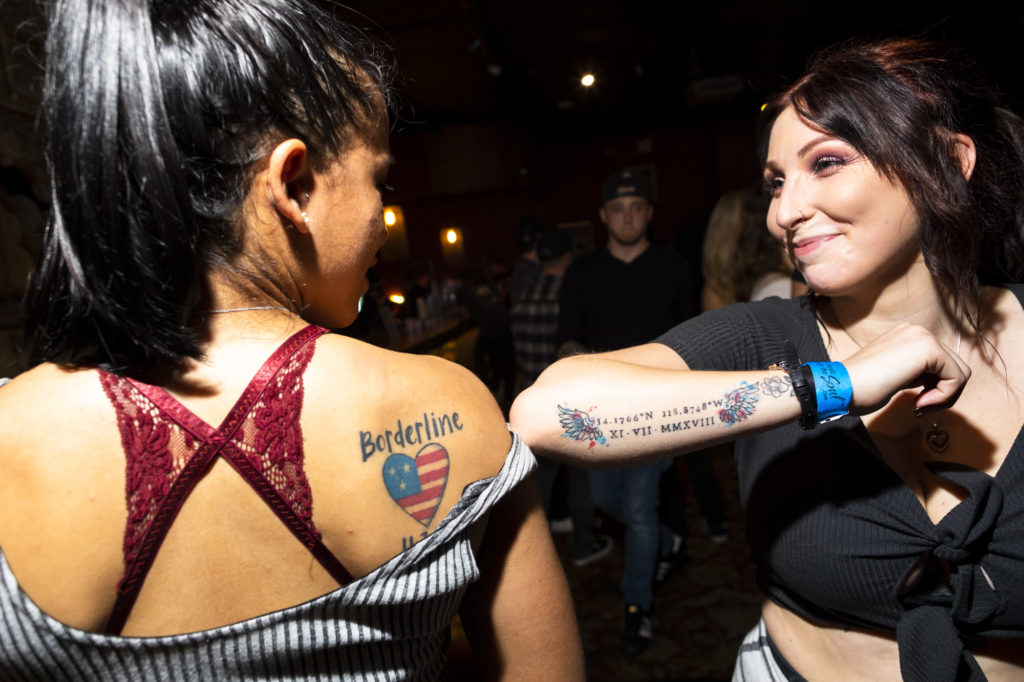
I’ve never been to Borderline or spent much time in Simi Valley, but I grew up not too far away, in Santa Clarita, a city with similarly conservative politics and an abundance of young people with little to do (Simi Valley and Santa Clarita are the only cities in their respective counties to have voted to support President Trump’s lawsuit against California’s sanctuary law). I’m not much older than many of the people who considered Borderline their regular hangout, and when I found the bowling alley fundraiser listed on a public calendar on Borderline’s website, I knew I wanted to meet the people who went there, to hear their stories, long after the national news crews had come and gone.
At the bar of Simi Valley Bowl, almost everyone I speak with describes Borderline as a “family,” to the point where I begin to wonder if they’re repeating the same feel-good phrases they’ve rehearsed for the media. Among them is Stephen Cook. When I ask him what earlier news reports may have misunderstood about the country music outpost, he says he takes issue with its description as a bar—despite that it was, by way of name and business, a bar and grill. “It’s not a bar. It’s a family,” he insists.
Or as one regular, Austin Dougherty, puts it: “The bullshit from outside didn’t really get inside because I think the main rule there was just don’t be a dick.”
Borderline first opened along Pacific Coast Highway in Malibu in the late 1980s and moved to Thousand Oaks, a wealthy suburban enclave straddling L.A. and Ventura Counties, in 1993. Cradled by the 101 Freeway, Borderline found its niche as a hangout for students of at least seven different colleges, including those as close as Cal Lutheran, a four-mile drive east, and as far as University of California Santa Barbara, some 60 miles north. Though it felt as intimate as a dive, Borderline billed itself as “Ventura County’s largest country dance hall & live music venue,” with a barn-like stage and 2,500-square-feet wooden dance floor. Twenty-somethings often showed up alone, knowing they’d run into friends once they got there, like in a TV sitcom in the days before cell phones required endless text-based coordination and anxiety.
“It’s like a giant high school party every week,” says Seybold, the Borderline DJ. (He went to a high school that was a rival to my own and says he knows some of the same friends as me.) “It’s got a lot of drama inside… who’s dating who, who’s interested in whom… and that’s totally fine because it makes it funny sometimes.”
Bo Cooper, a former pro wrestler who hosted and promoted an event he calls “midget wrestling”—he claims it was Borderline’s top-selling event—started going to Borderline in 1997. He’d drive from his home in Palmdale, more than 70 miles northeast. “I was like 18 years old and I would just go there to party and chill with chicks,” says Cooper, who is bald with a white beard and tattoos inked across his arms and neck—a switchblade with the words “trust no one” on the left side and two bullet holes on the right.
When he admits he’s “not such a huge fan of country,” I ask him what compelled him to make this commute. “Country girls, man. There was a lot of ratios. Cute girls,” he says. “Sunday night was family night back then, so we could get into a bar and not drink alcohol and still hang out.”
Besides, he continues, “It’s not one of those club scenes where, you know, you could get into a fight and all that bullshit. It’s one of those situations where you could actually go there and let loose and that’s what the tragedy about this whole thing was is that people felt so comfortable being at Borderline because it was like a family there and no one could imagine that this would ever happen.”
Cooper is eager to compare notes with me about the places we used to hang out in Santa Clarita, but not everyone at Harley’s welcomes my presence. Shortly after I show up and start talking to people, two women who look to be about my age shout at me from across the bar and ask me which outlet I’m with.
I tell them about theLAnd, a new kind of publication that’s less interested in parachuting into national events and more interested in covering less obvious local stories—which sometimes means showing up to a bowling alley just outside L.A. County and starting uncomfortable conversations with people in mourning. They begin to loosen up to me. They tell me they’re sick of reporters showing up to their friends’ funerals, of live-streaming them on Facebook. And they don’t want to talk about politics. A lot of reporters, they say, want to politicize the shooting, to use it as an excuse to talk about gun control. I guess I am one of them.
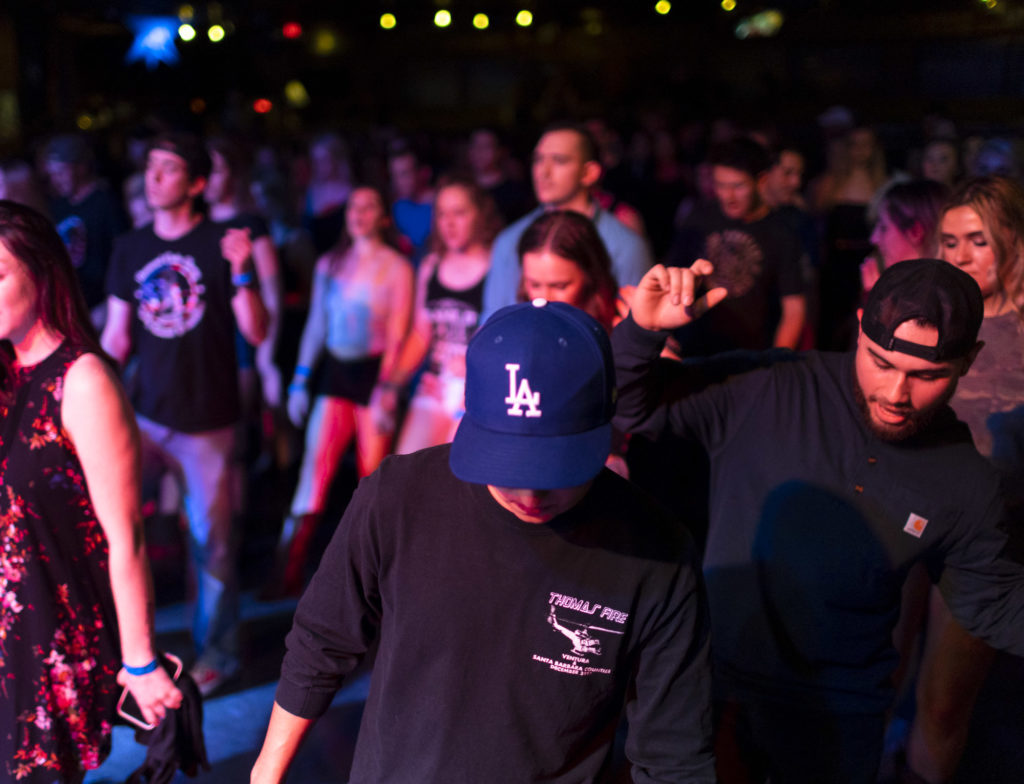
There’s no eloquent way to ask a mass shooting survivor why he believes mass shootings keep happening, what can be done to stop them and how it is we’ve managed to become so shamefully numb to them, but here we are, and so I do it anyway. Steinhauser knows these question are coming, and he knows that “a lot of people will disagree with me and that’s okay.” It’s tricky, he says. “I own guns. I used to shoot competitively, and unfortunately being affected by these situations twice now, it really hasn’t changed my opinion. Because, you know, I know that my guns are never going to harm anybody.”
“Anytime there’s a tragedy and somebody’s upset, they want a fix. They want an answer, they want a solution to, ‘this will never happen again,’” says Steinhauser. “The first thing we can think is, you know, ‘let’s get rid of guns.’”
We’re sitting at a counter behind the bowling lanes and people are starting to trickle out behind us, carrying bow-wrapped raffle prizes out the door. The staff is setting up folding tables for the next event, a children’s Christmas party. The impossibly upbeat tune of “Turning Japanese” plays over the loudspeaker while I strain to understand what seems like a jarring disconnect between Steinhauser’s support for guns and the horror he’s seen them inflict.
“My big problem is, even if we snap our fingers and get rid of every single thing, that only takes guns away from people that we know that have them,” Steinhauser says. “If people are getting guns illegally, if people are getting guns from across the border or something like that, we have no control over that.”
This is one of the arguments President Trump has frequently made in an attempt to justify his border wall proposal. But an FBI survey released last year found that a vast majority of the guns used to commit mass shootings in America were either obtained legally and specifically for the purpose of the shooting or were already in the shooter’s possession. (A 2013 University of California San Diego study found that nearly half of American firearm dealers were financially sustained by business from Mexico, not the other way around.)
Merrill walks over to the counter where we’re sitting and I tell her I’m struggling to wrap my head around her experience of having survived two mass shootings. I tell her I’m scared that mass shootings will become a routine part of American life, if they haven’t already. “It’s not going to stop anything that I do. You can’t live like that,” she says. “It happened once, it sucked, obviously. Then the second time, unfortunately, I knew how to react. Which is probably the scariest part to me, I guess, is that my initial reaction was like, I didn’t even think twice.”
I’m curious, does she think calls for tighter gun control are productive? “We have gun control,” she says. “The fact is, I think, mental illness needs to be approached and some sort of mental evaluation or something, I don’t know how we would do it, but something needs to be [done].” (Ventura County Sheriffs were called to Thousand Oaks gunman Ian David Long’s home in April 2018 after reports of a disturbance. They decided not to detain him on a temporary psychiatric hold.)
While Seybold and many others in the Borderline community tell me that they have no strong feelings about gun control, at least one woman does: Susan Orfanos. A clip of the grieving mother, whose 27-year-old son, Telemachus, was killed at Borderline Bar & Grill, went viral after news cameras captured her seething with rage. “My son was in Las Vegas with a lot of his friends and he came home. He didn’t come home last night,” she said the morning after the shooting, her voice quivering as if she weren’t entirely sure she could still speak words at all. “And I don’t want prayers. I don’t want thoughts. I want gun control and I hope to God nobody else sends me any more prayers. I want gun control.”
Merrill has no doubt that the two mass shootings have changed her life, sometimes in ways that are hard to put into words to people who haven’t gone through it. Now, when she walks into a bar, the first thing she thinks about is how she’s going to get out of it if something terrible were to happen. She always scans a room for exits. She even changed her desk at work, a talent payroll company, so that her back no longer faces the walkway. “I just don’t like my back to anything anymore and I like to know what’s going on and being aware,” she says. “I didn’t think it would ever happen once to me, let alone twice. It’s just now I’m really aware of where I am. Even after Route I was really aware.”
“It was hard,” Hickernell chimes in, recalling that she and another friend went with Merrill to see country singer Eric Church at the California Mid-State Fair last summer. “We just kept Dani in the middle and were making her comfortable, and we left a little early.”
Merrill starts crying and Hickernell wraps her arms around her. “Don’t do that, don’t do that,” she says, then reconsiders. “We haven’t had our moment like this… We’re all like, ‘Don’t let the mascara run!’” Before today, the two friends had only seen each other briefly since the shooting, including at a memorial service for Telemachus Orfanos — or as they knew him, Tel — at the Infiniti dealer where he worked.
The fundraiser, which raised roughly $13,000 for families of the victims, is winding down, but nobody wants to be alone just yet. Some friends go to Merrill’s house to hang out. Others go to a Christmas-themed Borderline vigil at Simi Valley Town Center, where they line dance for hours in cowboy hats and cowboy boots.
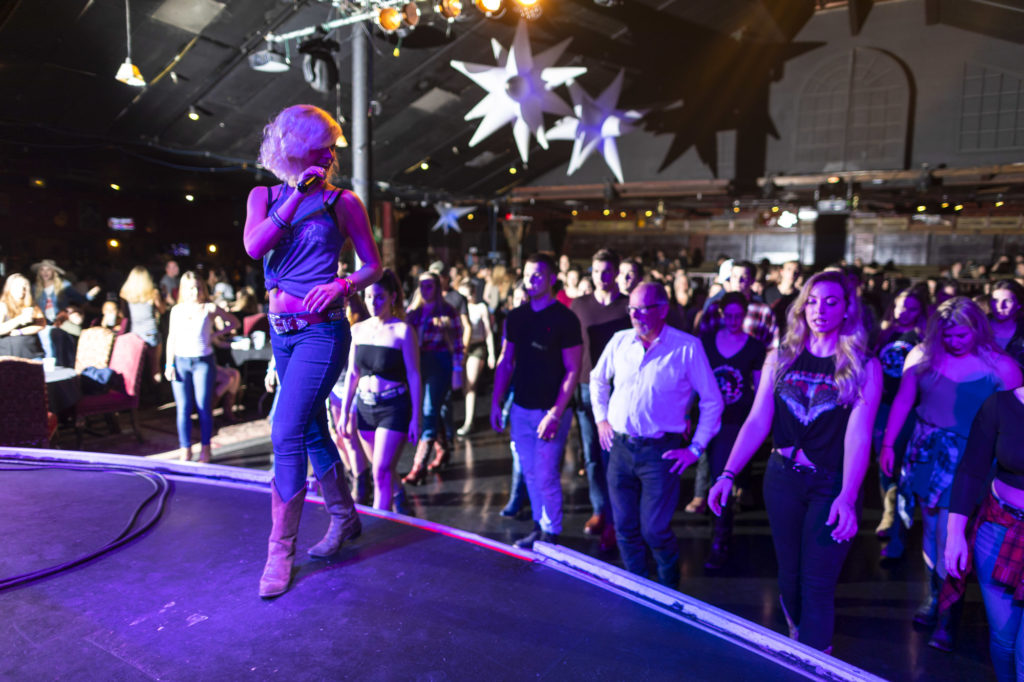
On a rainy Wednesday in mid-January, I show up to Borderline country night at the Canyon Club in Agoura Hills, a venue that shares a shopping center with an antique mart, a perfumery and an upscale Mexican cantina. There’s a metal detector at the door, and inside a mechanical bull never seems to get a rest. It’s cold and miserable outside—not the type of weather anyone conjures when they think of Southern California—but you’d never know it given the number of women wearing short denim cut-offs, cowboy boots and crop tops (Among them, one that reads “Bad and Boozy”). Flannel is practically a uniform here.
At the bar, I run into Cook, the guy who took offense to Borderline’s description as a bar. I ask him how tonight compares to a typical Wednesday in Thousand Oaks. “It’s like Borderline but it’s not,” he says. “It’s nice of them to open their house for our family.”
DJ Josh Kelly, who used to play music at Borderline, pumps out techno remixes of country ballads like Rascal Flatts’ “Fast Cars and Freedom” (“You don’t look a day over fast cars and freedom / That sunset river bank first time feeling) and all the denim-clad people on the dance floor somehow synchronize their bodies together in a series of highly choreographed moves. Not everyone looks like someone who listens to country music. There are boys who look like high school jocks (some have X’s Sharpied on their hands to indicate they’re under of 21), a college-age woman who wears a Sex Pistols t-shirt and a group of guys who seem like they’d fit in better at a Weezer concert. But all of them, against all stereotypes, know how to line dance.
Their ease with twirling and two-stepping would suggest they didn’t just learn these moves, during one of three line dance lessons offered throughout the evening. Rather, most people here have been perfecting these routines for years. These are not dance routines you will find on YouTube or Instagram. Many of them were created by Borderline instructors and taught specifically to Borderline regulars. Their footwork is a badge of belonging, a testament to the countless hours stomping on the dance floor on Wednesday nights in Thousand Oaks. Some songs, like “Redneck Angel” have inextricable titles; others, like “Shape of You” (yes, like the Ed Sheeran jam) and “Fake ID Dance” (a nod to the less notable Big & Rich featuring Gretchen Wilson track) are named after the song in which the moves are set.
Line dancing, I discover during the 10 p.m. lesson, is far more difficult than it looks. “Rock, recover, shuffle, pivot,” the instructor commands, as if I know how to translate any of these words into physical movements. Line dancing, it also occurs to me, is not the wholesome family activity I somehow always imagined it to be. Sure, it’s dorky, but it can also be raunchy. Especially when it’s set to Salt N Pepa’s “Push It” remixed with Shania Twain’s “That Don’t Impress Me Much” and Tone Loc’s “Wild Thing.” There is pelvic thrusting, followed by several sets of synchronized hand claps, creating a sound and motion that exudes confidence no matter who is creating it. Some dancers count off the numbers to the routine as they go. The steps are calculated, but everyone adds their own twist.
Near the opposite end of the venue, I spot Cooper, the former pro wrestler with the neck tattoos, and ask him to describe the night. “It feels revived,” he says. “You went from a family at Borderline to an even bigger family here.”
At Harley’s, these kinds of quotes sounded at first to me like rehearsed sound bites intended to appease a reporter. But the more I watch completely disparate-looking people line dance and clap and thrust in unison to dubstep remixes of “Blurred Lines,” the more I am convinced of their authenticity.
Seybold tells me that tonight feels like a typical Wednesday night at Borderline, but that things haven’t gotten back to normal just yet. There’s a memorial set up outside of Borderline, rows of white crosses on the street corner, and he and his friends still go visit regularly. “A lot of people will go out, have a six pack. take a shot,” he says. “Commemoration goes on everywhere.”
The opening notes of a remixed Tom Petty song, “I Won’t Back Down,” pipe in over the loud speaker and everyone starts in again on the dance floor.
Rock, recover, shuffle, pivot. Rock, recover, shuffle, pivot.